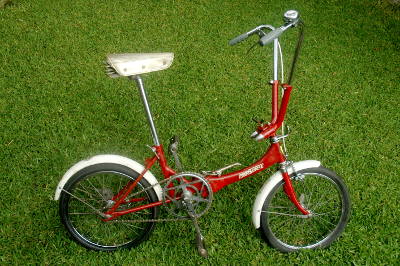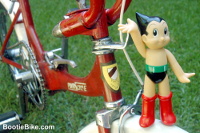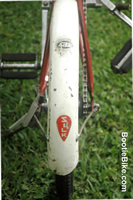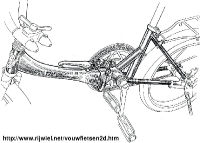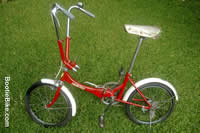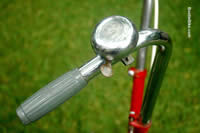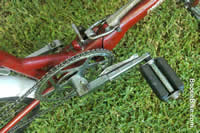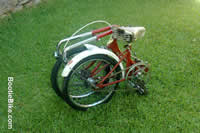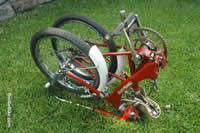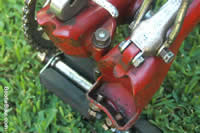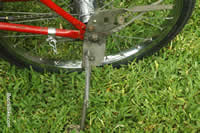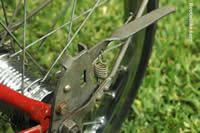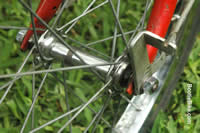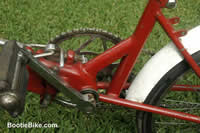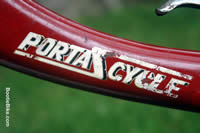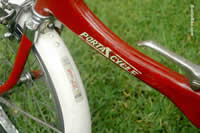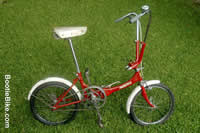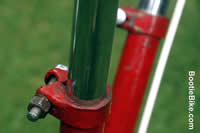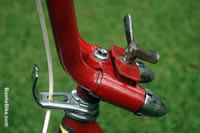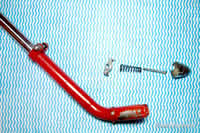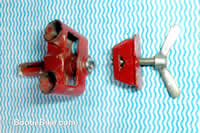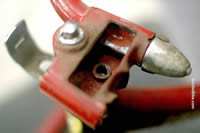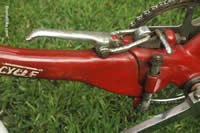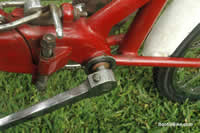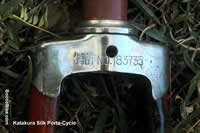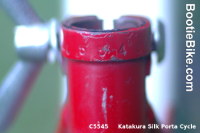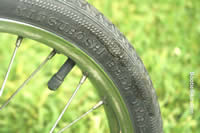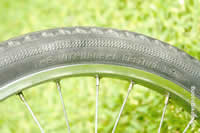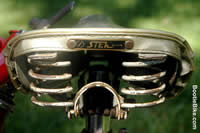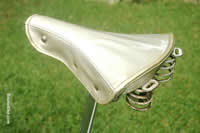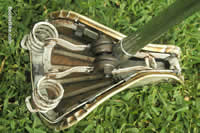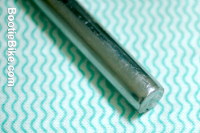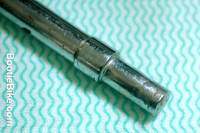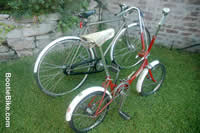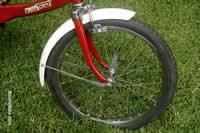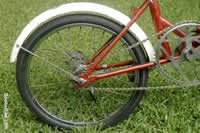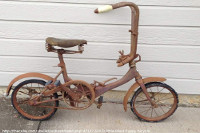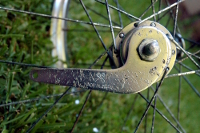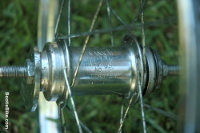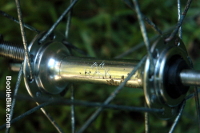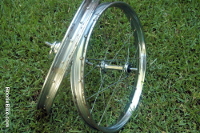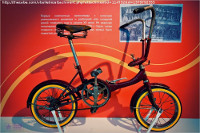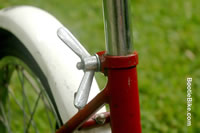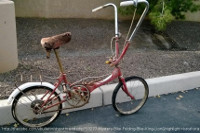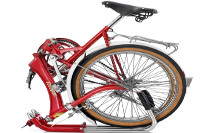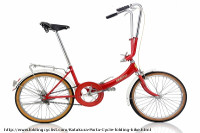1950s – 70s Katakura Silk Porta Cycle
Pioneering Japanese portable cycle
Dear reader, before proceeding I'll let you in on a secret: when I first contemplated the Porta Cycle, this fascinating, bizarre, period piece, in its neglected state, I doubted it would ever be a riding proposition. A great display perhaps, something to show off, but not to be ridden. But it proved me wrong, and I have come to like the little beast.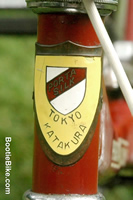
The Porta Cycle is a product of the Katakura company, which began producing bikes after the war in an aircraft parts factory near Yokota, in western Tokyo. The ‘Silk’ brand name dates from 1954, deriving from the silk factory they later occupied.  Silk bikes became famous when they were used by the 1964 Japanese Olympic team, and the brand, with its extensive range, went on to play an important part in the Japanese cycle industry. A victim of the rampant yen in the 1980s, Silk didn’t see out the 90s, but the name has been revived by a former employee.
Silk bikes became famous when they were used by the 1964 Japanese Olympic team, and the brand, with its extensive range, went on to play an important part in the Japanese cycle industry. A victim of the rampant yen in the 1980s, Silk didn’t see out the 90s, but the name has been revived by a former employee.
The Porta Cycle joined the Silk range in the 1950s after the design was acquired from Norishige Yokomaki, an automotive engineer who had created it for his personal use in 1951. It was patented in the USA in 1957.
No machine could have made this
I refer to the Porta Cycle as a 'period piece' because one look shows it's from the time when many Japanese goods were still on their upward trajectory to being the superb stuff we've come to know and love.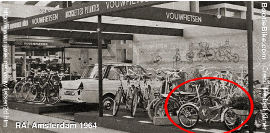 The hand work in it is very evident – no machine could have made this, and there is obvious attention to detail.
The hand work in it is very evident – no machine could have made this, and there is obvious attention to detail.
Have a squiz at the seatpost, for example, all half a metre of it. Both ends are closed, and the upper end, where the saddle clamp fits, is a work of engineering art compared to the cheap and cheerful, yet equally functional, common or garden seatpost seen on almost any other old bike. Why did they go to all that trouble?
Folding the Porta Cycle
The frame, in two large, curved, tapered channel sections, is secured by an over-centre latch, like the lock from a tool box. The join doesn't look very secure, but use has proved those carefully shaped frame ends stick together like glue. 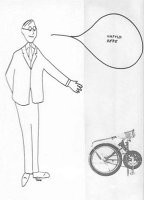 Hidden within the join is a pair of screws to adjust the alignment. The two frame pieces are hinged together very loosely, allowing them to shift relative to each other as the bike is folded. A hook on the end of the front axle mates with a spring-loaded catch on the rear, forming a convenient, single unit for hassle-free carrying and stowage. It works well, but on the way one must wrestle with an unruly mess of bike halves, each determined to go its own way, until they are aligned.
Hidden within the join is a pair of screws to adjust the alignment. The two frame pieces are hinged together very loosely, allowing them to shift relative to each other as the bike is folded. A hook on the end of the front axle mates with a spring-loaded catch on the rear, forming a convenient, single unit for hassle-free carrying and stowage. It works well, but on the way one must wrestle with an unruly mess of bike halves, each determined to go its own way, until they are aligned.
Before folding the bike it is necessary to flip up the drive-side crank, (an idea later adopted by the Dahon Classic III). The crank is split into a hinged, 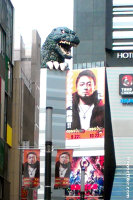 moveable part and a fixed stub attached to the chainwheel. A spring-loaded arm on the back prevents the hinged part swinging out of alignment (i.e. outwards) with the stub when the bike is ridden. Rotate the spring-loaded arm and the moveable part of the crank can be swung out of the way. (Sadly the chainwheel on this bike is missing its circular chainguard.)
moveable part and a fixed stub attached to the chainwheel. A spring-loaded arm on the back prevents the hinged part swinging out of alignment (i.e. outwards) with the stub when the bike is ridden. Rotate the spring-loaded arm and the moveable part of the crank can be swung out of the way. (Sadly the chainwheel on this bike is missing its circular chainguard.)
The folded bike can sit upside down on the platform created by the handlebars after they have been loosened and swung around 180°. The lower end of each handlebar rotates within a socket in a unique cast steering stem. They're secured in the desired position by a large 'wingbolt' with an extra fine thread so it takes ages to tighten or loosen. Screw it down and a cast clamping piece acts on an indent on the end of each bar to stop it 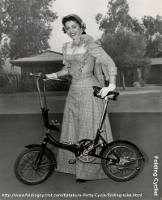 rotating, mostly. I say mostly because there remains a few degrees of movement in each bar, no matter how hard one tightens that wingbolt. I'm not totally sure if this has resulted from wear in the clamping parts or if it was designed to be that way, but I suspect the latter as there isn’t any visible wear to account for it, and no amount of tightening makes any difference – but who would know on this thing? In any case it's fine to ride once you get used to it. It's just a Porta Cycle kind of thing.
rotating, mostly. I say mostly because there remains a few degrees of movement in each bar, no matter how hard one tightens that wingbolt. I'm not totally sure if this has resulted from wear in the clamping parts or if it was designed to be that way, but I suspect the latter as there isn’t any visible wear to account for it, and no amount of tightening makes any difference – but who would know on this thing? In any case it's fine to ride once you get used to it. It's just a Porta Cycle kind of thing.
A pair of small springs, each within a space-age conical housing, helps locate the 'riding' position for the bars when unfolding the bike. Each spring presses a small tab into a notch on the edge of the stem (with a satisfying 'click') when it reaches the right place. I have read on the net that the handlebars are spring-loaded to help isolate the rider's hands from road shocks transmitted through the small wheels. I don’t think that's true, and I don't see why the transmission of road shock through those long bars should be an issue. In any case, the Porta Cycle is reasonably comfortable for the short trips for which it is intended.
Parking gymnastics
The appearance of the fork crown is unusual in that it gives the impression it is back to front. This can be a bit disconcerting at first, as one can momentarily think that the front wheel has swung around to face backwards. 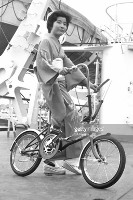 Funny but, left to its own devices, the front wheel tends to do that anyway. Given the slightest opportunity, the top-heavy handlebars, small front wheel and very ‘quick’ steering conspire to flop the front end of the parked Porta Cycle to one side, more often than not with sufficient force to initiate a slo-mo pirouette around the rear-mounted sidestand that continues until the bike is almost facing the other way.
Funny but, left to its own devices, the front wheel tends to do that anyway. Given the slightest opportunity, the top-heavy handlebars, small front wheel and very ‘quick’ steering conspire to flop the front end of the parked Porta Cycle to one side, more often than not with sufficient force to initiate a slo-mo pirouette around the rear-mounted sidestand that continues until the bike is almost facing the other way.
This amusing little feature can make one's attempts to park the bike a spectator event, as it can go on like this repeatedly. And you're never really sure which way the bike will be facing when you return. All part of the Porta Cycle way.
Changes to this bike to make it more usable
Less amusing was the need for a front brake and an extra gear or two. 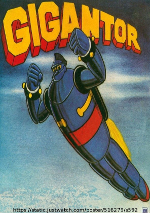 Some Porta Cycles were fitted with a three speed Shimano rear hub and a caliper brake up front, but this example had only a single speed and coaster (back pedal) brake. This proved challenging, as the wheels have the old fashioned 'Westwood' rims with 20 holes; modern brakes don’t work on those rims, and multispeed hubs don’t come with 20 holes. Both of these issues were solved by substituting Moulton wheels for the originals. They’re the same size, and they have a geared hub-friendly 28 holes.
Some Porta Cycles were fitted with a three speed Shimano rear hub and a caliper brake up front, but this example had only a single speed and coaster (back pedal) brake. This proved challenging, as the wheels have the old fashioned 'Westwood' rims with 20 holes; modern brakes don’t work on those rims, and multispeed hubs don’t come with 20 holes. Both of these issues were solved by substituting Moulton wheels for the originals. They’re the same size, and they have a geared hub-friendly 28 holes.
I was able to use one of the original tyres 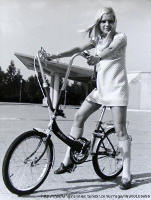 (by The Mitsuboshi Belting Ltd), which I run on about 45 psi. The other tyre is a new Raleigh Record (55 psi). The multi-speed rear hub I chose is a two-speed Fichtel and Sachs 'Duomatic', with coaster brake. This is enough to make the bike more usable, but it's still hard work on some of the hills, because the frame limits the rear sprocket to 16 teeth (the gearing works out at 52 gear inches for low and 71 for high).
(by The Mitsuboshi Belting Ltd), which I run on about 45 psi. The other tyre is a new Raleigh Record (55 psi). The multi-speed rear hub I chose is a two-speed Fichtel and Sachs 'Duomatic', with coaster brake. This is enough to make the bike more usable, but it's still hard work on some of the hills, because the frame limits the rear sprocket to 16 teeth (the gearing works out at 52 gear inches for low and 71 for high).
The original Nankai (NK) coaster hub, safely stored, has helped to date this particular Porta Cycle. It was in 1970 that Nankai started making their own type of hub instead of the 'New Departure' type they had been making. So the bike is one of the younger ones, probably in its mid-forties. The bike certainly looks every minute of 45 years old, if not 145. I do hope it lasts that long, as I think the world would be a more boring place without it.

With thanks to:
Vintage motorbikes and bikes
Classic Rendezvous
The Invitation for Cycling by Mr.Gami: The Catalog of Reminiscence
Falträder(2)
PBase/jchiarella
The Flying Pigeon Project
Bicycle Design: An Illustrated History. Hadland and Lessing, MIT Press 2014

